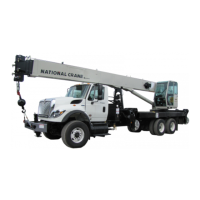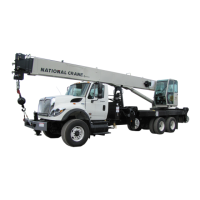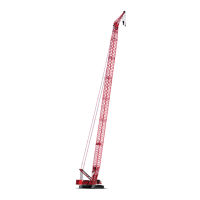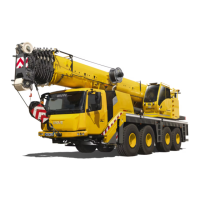Manitowoc Published 09-10-14, Control # 065-24 1-57
14000 SERVICE MANUAL INTRODUCTION
Mast System
See Figure 1-32 and Figure 1-34 for the following procedure.
The mast is a rectangular shaped structure that supports the
boom. The mast is also used for crane assembly and
disassembly. Mast raising cylinders provide assistance to lift
and lower mast during reeving of mast and gantry sheaves.
The mast-raising/lowering sequence is controlled
automatically by the computer program and boom hoist
control handle. See Drum 4 (Boom Hoist) System topic in
this section for boom hoist operation.
Mast raising and lowering rate is controlled by engine speed,
as it regulates pay out and haul in of the cable reeving
between boom hoist sheaves and mast sheaves.
Mast system faults appear on information screen when the
mast is inoperable in either direction or mast is at maximum
lower position.
When not enabled, mast raising cylinders are motor spooled
where both cylinder ports and tank port of valve spool section
are connected in center position. This type of spool prevents
premature opening of equalizing valves. Load equalizing
valves ensures mast raising cylinders operate in unison,
protecting the mast from structural damage caused by
twisting. Load equalizing valves also provide support
resistance against the mast to ensure control of the unit
while rotating. When an accessory valve spool shifts, supply
flow to the other accessory valves is limited. The accessory
system pressure sender monitors accessory system
pressure.
When mast switch is placed in raise position and held, an
input voltage is sent to node 1 controller. Node 3 controller
sends a 24 volt output to enable mast cylinders raise
solenoid HS-22 and shifts valve to raise position. Node 4
controller also sends a variable 24 volt output signal to drum
1 pump EDC to stroke the pump in low-pressure direction to
provide accessory system pressure. See automatic raising/
lowering procedure below for complete cylinder operation.
When mast switch is released, solenoid HS-22 returns to
center position. Node 4 controller sends a zero volt output
signal to drum 1 pump EDC to de-stroke the pump.
When mast switch is placed in lower position and held, an
input voltage is sent to node 1 controller. Node 4 controller
sends a 24 volt output to enable mast cylinders lower
solenoid HS-23 and shifts valve to lower position. Node 4
controller also sends a variable 24 volt output signal to drum
1 pump EDC to stroke the pump in low-pressure direction to
provide accessory system pressure. See automatic raising/
lowering procedure below for complete cylinder operation.
When mast switch is released, solenoid HS-23 returns to
center position. Node 4 controller sends a zero volt output
signal to drum 1 pump EDC to de-stroke the pump.
Mast Raising
Use Rated Capacity Indicator/Limiter, Diagnostic screen to
select the Liftcrane Mast Handling Capacity Chart. Mast and
gantry controls will not operate and mast operating limits
remain off until the Liftcrane Mast Handling Capacities Chart
is selected.
Raise the gantry to working position until back hitch pins
automatically engage.
Use mast switch on overhead console in cab to raise mast
assist arms to at least 35° and stop.
Move drum 4 (boom hoist) control handle forward to continue
automatic mast raising procedure. Node 4 controller sends a
variable 24 volt output signal to drum 1 pump EDC to stroke
pump in low-pressure direction. Node 3 controller sends a 24
volt output to enable mast cylinders raise solenoid valve HS-
22 in extend (mast raising) direction. Solenoid valve shifts to
block tank port and open port to low-pressure side of drum 1
pump.
Mast assist arms extend automatically as the mast raises
from transport position. Drum 4 pays out wire rope between
drum 4 and gantry sheaves. A speed sensor at motor
monitors drum rotational speed.
Fluid pressure from accessory valve enters the free-flow
check valve sections on side A of load equalizing valve.
From equalizing valve, fluid enters counterbalance valves
and piston end of mast cylinders, extending cylinder rods to
raise mast.
Fluid flow from rod end of mast raising cylinders is blocked
by free-flow check valve sections on side B of
counterbalance valves and flows through valve flow restrain
sections preset for a relief pressure of 3,500 psi (240 bar).
Counterbalance valves operate with a 5:1 pilot ratio of the
relief valve pressure, permitting valve to open when pressure
in rod end of the cylinders is approximately 700 psi (48 bar).
Hydraulic fluid from side B sections of both counterbalance
valves combines and free-flow check valve section on side B
of load equalizing valve blocks the flow.
Fluid then passes through valve flow restrain section that is
preset at 4,000 psi (275 bar). Load equalizing valve operates
with a 1.5:1 pilot ratio of the relief valve pressure, permitting
valve to open when hydraulic pressure on side A of load-
equalizing valve is approximately 2680 psi (185 bar).
Restraining section on side B of load equalizing valve opens,
controlling flow of fluid out of the cylinders to ensure cylinder
operation is balanced.
